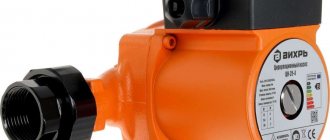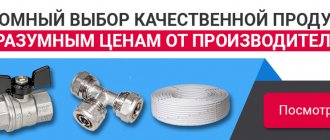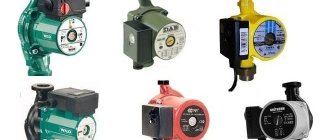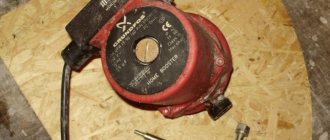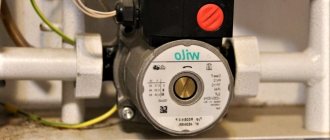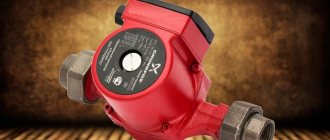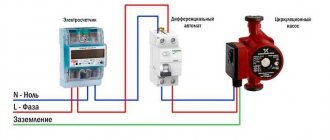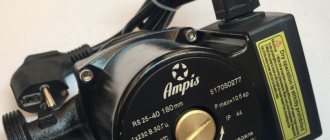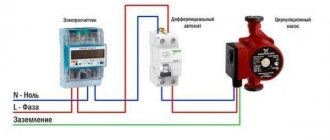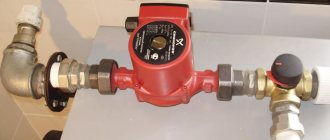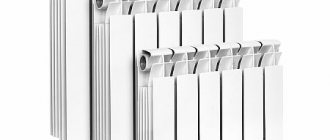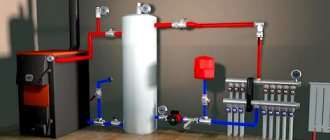In new country houses, there is now almost no heating system with natural circulation, when water heated by a boiler moves through the pipes by gravity due to the fact that the hot coolant, due to greater expansion, displaces layers with a lower temperature. To make it actively move along branched and extended wiring without getting stuck in the radiators, you need a circulation pump for Wilo heating. You can choose a unit of another brand, but this publication will be devoted specifically to it.
Pump in the heating system Source rusinfo.info
How the unit works
The principle of operation of the circulation unit is very similar to the operation of a drainage pump. If this device is installed in a heating system, it will cause movement of the coolant by capturing liquid on one side and pumping it into the pipeline on the other side
The principle of operation of the circulation unit is very similar to the operation of a drainage pump. If this device is installed in a heating system, it will cause the movement of the coolant by capturing liquid on one side and pumping it into the pipeline on the other side. All this happens due to the centrifugal force, which is formed during the rotation of the wheel with blades. During operation of the device, the pressure in the expansion tank does not change. If it is necessary to increase the coolant level in the heating system, install a booster pump. The circulation unit only helps water overcome the resistance force.
The device installation diagram looks like this:
- A circulation pump is installed on the pipeline with hot water coming from the heater.
- A bypass valve is installed on the section of the line between the pumping equipment and the heater.
- The pipeline between the bypass valve and the circulation pump is connected by a bypass to the return pipeline.
This installation scheme involves the release of coolant from the device only if the unit is filled with water. To keep the liquid in the wheel for a long time, a receiver equipped with a check valve is built at the end of the pipeline.
Circulation pumps used for domestic purposes can develop a coolant speed of up to 2 m/s, and units used in the industrial field accelerate the coolant up to 8 m/s.
It’s worth knowing: any type of circulation pump operates from the mains. This is quite economical equipment, since the motor power for large industrial pumps is 0.3 kW, and for household appliances it is only 85 W.
Pressure equipment for water supply
Self-priming pumping station "Wilo" PW-175EA
Like other pumping stations from this manufacturer, it consists of a self-priming centrifugal pump, a pressure switch, a pressure gauge, and a hydraulic accumulator. It has a reliable electronic module that allows operation without user intervention. Designed for clean drinking water, but also allows for the distillation of rainwater. Without immersion in a water tank, it pumps liquid from a depth of up to 8 m.
Peculiarities:
- shutdown in the absence of water consumption;
- heat-protected motor;
- capacious hydraulic receiver;
- small size and light weight, simplifying installation and transportation;
- equipped with a high-pressure pump pumping water from a depth of 8 m.
Specifications:
- Throughput – 2.2 m3/h;
- Head height – 40 m;
- Power – 350 W;
- Pressure – 4 bar;
- Receiver – 2 l;
- The diameter of the inlet/outlet pipes is 1 inch.
Pumping stations "Vilo" series Jet FWJ (left) and Jet HWJ
Their functional purpose is similar to the previous modification.
Used for irrigation and drinking water supply. They operate automatically. They differ from each other by the presence of a membrane receiver (only HWJ has it), which can be supplied in volumes of 20 and 50 liters. Advantages:
- anti-corrosion material design (steel, noril);
- overheat fuse;
- the ability to adjust the pressure level at which it will turn on/off. water pump;
- two-way connection - from the suction and pressure sides;
- ease of installation;
- do not require regular maintenance.
Operating parameters "Vilo" FWJ/HWJ (average for the series):
- Self-priming – 8 m;
- Jet height – 50 m;
- Productivity – 5 m3/h;
- Weight – 11.7/18 kg.
Water pump "Wilo" DRAIN TMW-32/8
The model is an automatic submersible pump with a stirring device. Can be used in both stationary and mobile conditions. Structurally, it is designed in such a way that a turbulence is continuously formed in the suction zone, which promotes the drainage of sewer pits, abandoned mines, pits in the most hygienic way today: without odor and sediment formation.
Peculiarities:
- electric motor with a dry rotor and a cooling circuit that prevents overheating;
- end and lip seals of the impeller and motor;
- vertical installation;
- resistance to short-term (3 min) increase in temperature 0C of the working environment up to +90;
- integrated float switch and check valve;
- Built-in Twister function that creates swirls.
Working properties:
- Traction – 450 W;
- Immersion – up to 3 m;
- The cross-section of the pressure pipe is ¼ inch;
- Network cable – 10 m;
- Pump D – 16.5 cm;
- Weight – 4.7 kg.
What materials are needed to connect the restriction when choosing a pump?
The installation of a heating system with water heating, operating on the basis of natural or forced circulation, will create the required level of heat in the room. This process will not depend on central heating. To ensure that the circulation pump moves water correctly in a forced heating system. it must be installed correctly. Installation of the pump structure does not require much space. According to the connection diagram, among the components of the heating system, along with the pump, there should be such parts and tools as:
Correct installation of the circulation pump.
- Membrane tank.
- Mesh filter.
- Coupling connection.
- Control block.
- Signal system.
- Valves.
- System make-up line.
- Grounding.
- Circulation pump.
- Emergency and temperature sensors.
- Wrenches (19-36 mm).
- Check valve.
- Bypass.
- Shut-off valves.
- Plug.
- Electrical cord.
- Welding machine.
The forced circulation system allows you to hide the main pipeline deep into the wall.
In order to optimize the heating system, you should carefully understand how it will function using the installed pump. The correct selection of a device, that is, one equipped with a split thread, will speed up the installation of the pump. This will allow you to avoid purchasing connections separately. After carrying out the preparatory work, you should read the instructions for the purchased pump and its design diagram in order to confidently begin installation yourself.
Connecting a circulation pump to heating is a popular procedure necessary to create the required pressure during operation of the entire system. At the same time, it becomes possible to create structures whose connection and operation principles differ.
A natural circulation system, unlike a forced one, will not make the return and main pipeline invisible, that is, hide it in the lower part of the wall. If the room height is small, part of the window will be blocked by the discharge pipe, so the appearance of the room will be disrupted.
Positive and negative aspects of choice
Glandless circulation pump
Modern heating systems most often operate on the principle of natural circulation. But sometimes there is a need for forced circulation of the coolant. And then the question arises of choosing a suitable pump. The choice depends on many factors, the most important of which is the power of the device. It should be enough to generate the required feed intensity.
There are special mathematical formulas that allow you to make the necessary calculations. The finished tables are published on the Internet. They are also in the technical data sheet of the product. When choosing pump power, the area of the heated room and the speed that the circulation pumps are capable of generating are taken into account first of all.
By choosing Wilo products, everyone receives in return a whole package of operational benefits:
- German products eliminate the possibility of heat losses that often occur during evaporation.
- All its working mechanisms are made of corrosion-resistant materials.
- The operation of the system is controlled automatically. There is a built-in thermostat, and all functions are displayed on the LCD display. However, there is a manual switching option that allows you to control the speed of the working shaft.
- Even the most powerful models operate completely silently. Almost all Vilo pumps are small in size, so their installation does not take up much space.
- Connection is quick and convenient thanks to the spring terminals.
- The rotor and motor have a multi-stage protection system, so the unit is not afraid of power surges.
There is only one drawback to such installations. Today, Wilo pumps can only be installed in areas where power supply problems are extremely rare. Without electricity, it is simply impossible to evaluate the advantages and quality of work of German equipment.
Wilo surface pump
Many years of experience allows the German company Wilo to produce high-quality pumping equipment that satisfies the widest consumer demand. Today it is used both in the household sector and in industrial production. High quality and ease of installation, ease of operation and the presence of a large number of technical advantages distinguish the products of the described concern among similar products. But this is not the most important thing.
German pumps can be connected not only to the heating system. They are widely used for air conditioning. The model range is represented by several dozen varieties. All devices are characterized by high performance, compact size, high power and low noise during operation.
Read further:
German Wilo pumps - technical characteristics, types and models
Danish circulation pumps Grundfos - technical characteristics and design features
Modern polypropylene pipes for heating - technical characteristics and operating features
Gas boiler Navien - technical characteristics, design features and model range
What is the difference between wall-mounted gas heating boilers - technical characteristics and operational features of the devices
Operating principle of the Wilo MTSL 155 HE 2 circulation pump
The main part of the pump is an electric motor, consisting of a stator with several inductance coils to regulate the rotation speed, and a rotor, which is integrated on a shaft with bearings.
When power is applied to one of the stator windings, an electric field is created that drives the rotor with the turbine. The turbine blades capture fluid from the suction pipe and move it along the outlet pipe. In this way, the coolant circulates throughout the entire heating circuit.
Let's look at the main reasons leading to failure of the Wilo MTSL 15/5 HE - 2 pump.
Unstable voltage in the network
With reduced power, the pump motor slows down until it stops completely. With increased voltage, the inductor coils heat up, which can cause an interturn short circuit or burnout of the winding wire.
Contamination of pump mechanisms
When the liquid temperature is more than 60 ᵒC, scale may form on the turbine and shaft, which will slow down the rotation of the motor armature. Causes of pump jamming can also be increased oxidation of the driving mechanisms or the ingress of foreign objects.
Poor quality component material
If the pump uses parts made from low-quality materials, its service life is sharply reduced. For example, a shaft begins to jam due to the formation of a layer of rust on the surface of the bearings, because they are made of bronze, which contains iron. Such symptoms are typical for a non-original model.
Improper use of the device
Water through a working pump must constantly circulate at a certain speed. If the flow of the coolant is disrupted (the return or supply valve is closed, the system filter is clogged, etc.), the bearings and inductors in the device will overheat - this will lead to jamming of the rotor, breakage or short circuit of the stator winding.
The Wilo MTSL 15/5 HE - 2 circulation pump cannot be used when there is no water in the pipeline. But since Ariston double-circuit automatic units are equipped with liquid pressure sensors, the boiler will not turn on if there is no water in the system or its pressure is low.
Main advantages
WILO pumps operate in automatic mode, but also have a manual control function.
The use of this type of pumping equipment in single-circuit and double-circuit heating systems is explained by the following advantages:
- minimum heat losses;
- use of corrosion-resistant materials in the design;
- the presence of built-in automation that controls the operation of the pump, including a thermostat;
- the use of indicator panels designed in the form of an LCD display;
- the permissibility of switching automation to manual mode;
- quiet operation of the electric motor, regardless of the power and performance of the pump.
The advantages of Wilo equipment also include compactness, which allows the units to be mounted in places chosen at the user’s discretion.
Spring-loaded terminals are used for connection; the electric motor is equipped with multi-stage protection, which reduces the likelihood of breakdown during sudden power surges in the network.
Heating models
| Wilo model | Connection, inch | Length, mm | Power, W | Price, rub |
| Star-RS 15/2 | 1 | 130 | 20 | 6450 |
| Star-RS 15/4-130 | 1 | 130 | 20 | 6900 |
| Star-RS 15/6 | 1 | 130 | 24 | 8250 |
| Star-RS 25/4-130 | 1 1.2 | 130 | 20 | 7120 |
| Star-RS 25/6-130 | 1 1.2 | 130 | 40 | 8500 |
| Star-RS 25/2 | 1 1.2 | 180 | 20 | 5550 |
| Star-RS 25/4 | 1 1.2 | 180 | 20 | 5550 |
| Star-RS 25/6 | 1 1.2 | 180 | 24 | 7000 |
| Star-RS 25/7 | 1 1.2 | 180 | 40 | 9570 |
| Star-RS 25/8 | 1 1.2 | 180 | 20 | 10290 |
| Stratos PICO 15/1-4 | 1 | 130 | 20 | 15000 |
| Stratos PICO 15/1-6 | 1 | 130 | 20 | 16900 |
| Stratos PICO 25/1-4 | 1 1.2 | 130 | 24 | 11000 |
| Stratos PICO 25/1-4-130 | 1 1.2 | 130 | 20 | 13800 |
| Stratos PICO 25/1-6 | 1 1.2 | 130 | 40 | 12200 |
| Stratos PICO 25/1-6-130 | 1 1.2 | 130 | 20 | 15100 |
Not all models are shown in the table, please contact us with your request.
Types and characteristics
A circulation pump is a centrifugal-type device, the impeller of which takes in and discharges liquid in a given direction. Like all similar devices, it works on suction and discharge with equal efficiency. Considering the specifics of use, these qualities are the main ones for it.
There are two main types of circulation pumps:
With wet rotor
The impeller of these pumps is mounted directly on the motor shaft. The pump housing is sealed, and a seal is placed on the shaft to protect against leaks. For household systems, such designs are considered the most suitable, since they do not create noise during operation. In addition, pumps with a wet rotor are capable of independently removing air pockets, and the liquid provides lubrication and cooling of the electric motor;
With dry rotor
The pump and motor are two separate units connected by a coupling or flange. Such designs are designed to work in large heating systems, as they can pump large volumes of liquids. The main disadvantage of dry pumps is the high noise level during operation, which is unacceptable at home.
Pumps: 1-With a wet rotor 2-With a dry rotor
Main technical characteristics of circulation pumps:
- Performance. This is a value indicating the amount of coolant pumped by the pump per unit time. Determines the ability of the installation to provide a given speed of fluid movement for the available volume of the system;
- Pressure They are often confused, but this is a wrong approach. The pressure shows how high a given pump is capable of lifting a column of liquid. For heating systems of houses with several floors, this indicator is very important, since the hydraulic resistance in the circuits is high and must be overcome;
- Engine power. This indicator is important because insufficient power will not allow the pump to perform its tasks, and excess power will make the pipes make a lot of noise;
- Maximum temperature. Since we are talking about a heating system, the coolant is hot. If the pump is unable to operate under these conditions, it will seize, leak and other problems will occur. It must be taken into account that when rotating, the parts of the device heat up, and an additional rise in temperature sometimes becomes an excessive load for them.
- Connecting dimensions. Installing the pump is simple, but it requires the appropriate elements. They should be selected immediately after purchasing the pump, so as not to find yourself in a difficult position during installation;
- Manufacturer. This factor does not significantly affect the operation of the system, but products from well-known and reliable companies are much more durable and do not create such problems as products from little-known companies.
When purchasing, it is recommended to carefully study the technical characteristics of the pump and compare them with operating conditions in the existing circuit. You should choose devices that can withstand temperatures of 110°.
Types of Wilo brand pumps
Wilo pumping equipment can significantly improve the heat supply process not only on an industrial scale, but also in local heating systems, such as private households or apartments.
Now many people know that installing a pump in an individual heating system with natural circulation allows not only to significantly improve the quality of heating, but also to significantly save on the consumption of natural gas or other types of fuel.
Of all the pumps that the manufacturer presents, models designed for use in heating systems are especially in demand. Let's take a closer look at their types and applications.
Pumps are available in two types:
- with dry rotor;
- with wet.
What is the fundamental difference?
Dry rotor pumps
The first type of pump means that the rotor of the electric motor is not in contact with water. The connection between the motor and the working part (housing) is made through special sealing rings that do not allow the pumped liquid to enter the electric drive.
We can say that such a pumping unit consists of two parts: the first part is an electric motor, the second part is a housing equipped with two pipes - one discharge, the other suction, and it also contains an impeller, which carries out pumping.
These pumps are usually used in systems with long pipeline lengths and large connecting diameters. They are widely used in industrial and heating boiler houses. The warranty period is from 3 to 5 years. It depends primarily on the brand and performance.
Equipment indicators:
- High level of efficiency - more than 80%;
- High requirements for the presence of suspended particles in the pumped medium. It is necessary to install filters to prevent foreign objects from entering the unit;
- The room where this equipment is installed should not be dusty. If there is dust, the O-rings quickly become unusable. Replacing rings is a labor-intensive process that requires special skills;
- The type of connection to pipelines is usually flanged.
Glandless Rotor Pumps
This type is most common for domestic needs. The design of pumps of this type is fundamentally different from those previously discussed. The electric motor and impeller are located directly in the housing, which has an inlet and an outlet. The liquid is pumped as if by the rotor itself, which, in turn, is equipped with an impeller (impeller).
Cooling and smearing of bearings is carried out directly by the pumped liquid. This type of equipment is used in heating systems with a short length and small diameter pipelines. Most often they are connected using a threaded connection.
Equipment indicators:
- Almost silent operation;
- Has a compact design;
- The ability to change operating parameters, which allows you to save on energy consumption;
- Long working life;
- Virtually no maintenance required.
Wilo products have proven themselves primarily for their energy savings, as well as a high level of quality and durability. The housings are made of gray cast iron or stainless steel, depending on the purpose of the pump. Working shafts are made of stainless steel only. Bearings are made of graphite.
Models of pumps with a wet rotor for heating systems are equipped with three-mode units for adjusting the speed of rotation of the impeller. These blocks are controlled manually. The temperature range in which such units can be operated is from -20 to +130 degrees Celsius.
This type of equipment is used in heating systems with a short length and small diameter pipelines
Areas of application
The Wilo brand produces pumps designed for different purposes and therefore having different characteristics.
With the help of such a pump, you can water the beds directly from a well, borehole or the nearest body of water.
The scope of their application is wide and varied:
- Wilo devices are used in heating systems in closed circuits.
- They are used in the water supply of private houses and in wells for water extraction.
- Such pumps are also suitable for pumping out groundwater when creating basements and cellars.
- They are also used on construction sites when working with contaminated water.
- Owners of private suburban areas have found good use for them, in particular those who grow plants on their plots.
You can connect the device yourself without any problems. For this purpose, it is equipped with special spring terminals. It does not have a fan, so there is virtually no noise during operation.
How to choose a pump for heating a private house
Wilo, as a pump for heating a private house, is used by owners everywhere. Selecting a pump is actually quite a delicate matter and of course it is necessary to take into account all the little things. You need to calculate the length of the line, take into account the number of radiators, do not forget about heat loss and much more. In general, as a rule, the design of a heating system is calculated at the stage of building a house and it is better to entrust such a calculation to a competent specialist. In addition, on the official website of the manufacturer Wilo, the online pump selection program - Wilo Select - can help you.
Wilo pump calculation
However, we can certainly give some indicative recommendations. For initial calculations, it is necessary to calculate the heated area and decide on the purchase of a boiler of sufficient power. Roughly enough, “by eye,” the required boiler power is calculated based on 1 kW per 100 square meters.
Having calculated the boiler power, it will not be difficult to find out the flow rate of our pump using the formula: Q=N/(t2-t1), where Q is the flow rate we need to select a pump in m3/h; N is the power of our selected boiler in watts; t2 – water temperature at the boiler outlet; t1 – water temperature at the boiler inlet.
Next, we need to determine from the hydraulic curve (which is attached to all pumps) the pressure we need. If you did everything correctly, then with a high degree of confidence we can say that your system will work properly. Do not forget that Vilo pumps are supplied with three speeds, so you can slightly adjust its operation locally. With frequency regulation, this will be even easier.
Specifications
First of all, the main technical characteristics of any pumps are:
- Volume of pumped medium per hour;
- Head or amount by which pressure can be raised;
- Purpose of the pump - for what purpose it is intended;
- At what voltage can the unit operate with a single or three-phase electric motor connection;
- According to the type of connection - they can be with a flange or threaded connection.
The most common Wilo brand pumps designed for heating systems in small industrial premises, residential buildings and apartments are:
Wilo Star-RS - available in three modifications, designed for heating systems and available with a unit for adjusting the flow rate of the pumped liquid. Depending on the series, they can pump a volume from 2 to 5 m3/hour, while the pressure can be from 0.2 to 0.6 atmospheres, type of design - with a wet rotor, threaded connection;
Wilo-TOP-RL - almost identical to the previous pump, differs in higher performance indicators. The volume of pumped liquid is from 6 to 9 m3/hour, the pressure is from 0.4 to 0.77 atmospheres. Type of execution – with a wet rotor, threaded connection;
Wilo-BL - differs from previous pumps with higher productivity from 5 to 60 m3/hour, pressure from 0.6 to 1.6 atmospheres. Type of execution - with a wet rotor, threaded or flanged connection.
The lineup
The concern is famous for its fairly wide range of products. The Wilo CAD catalog contains 142 series, among which the most common are:
- Wilo-Economy-CO – multi-pump and single-pump pressure boosting stations. They are assembled on the basis of vertical pumps MVI, Helix V, MVIS, MHI. 2-4 units are installed in parallel in the station, which increases operational reliability and productivity. Supplied with storage tank and solids separation system and control panel. The pressure varies from 60 to 160 m. The flow rate, depending on the pump, can be 14, 75, 80, 135 cubic meters per hour.
- The Wilo-Multivert MVI family are outdoor centrifugal devices for vertical placement. They provide water for irrigation installations and are components of boiler houses and fire extinguishing installations. The design and dimensions of MVI allow you to save space during installation. The MVI 2 series consumes 5 cubic meters per hour, head - 220 m, the fourth series - 8 cubic meters per hour, pressure - 210 m, the eighth - 14 cubic meters per hour at a pressure of 225 m.
- Star – a line of models with a wet rotor and a threaded connection type. There are 3 speed modes available. The devices are used for cold water supply and heating systems. Pressure – up to 8 m. Consumption reaches 6 cubic meters/hour.
- TOP - compact circulation pumps, with the ability to connect it to a pipe. They operate quietly, are ideal for pumping liquid through pipelines in private homes, and are thermally insulated. Pressure – 9 m, flow – 65 cubic meters/hour.
- The Wilo Helix pump family is a multi-stage equipment belonging to the subtype of non-self-priming pumps with a flow rate of up to 93 m3/h and max. pressure up to 240 m. The units are equipped with a dry rotor, each unit has a frequency converter and air cooling.
- Stratos are highly energy efficient circulation devices. Applicable in heating systems, cooling circuits, air conditioning. The company also creates various control devices. For example, Wilo SK 702 is a device for controlling, protecting and monitoring pumps against overcurrent and dry running.
- The Wilo Comfort Vario pump line includes 3 series, differing in design features. The controller can connect up to 4 products in parallel.
Wilo Comfort Vario pumps
Popular models, their technical characteristics
The most popular models are:
- WJ 203 EM is a self-priming water supply station with a 50-liter tank and a power of 0.75 kW. Max. pressure – 41 m, flow rate – 5 cubic meters/h;
- Star-RS 25/4 is a circulation model of a balanced design, used in heating and hot water supply systems. Pressure – 4 m. Connected to the power supply, the unit operates in one of three stages of rotation. VIT has a 2-way cable drive, stamps;
- installation with a cutting mechanism for sewage disposal Wilo Hisewlift 3-35 with a power consumption of 0.4 kW and a direct start type. Rated rotation speed – 2900 rpm. Tank volume – 17 l;
- Wilo JET HWJ 204 is a portable self-priming jet device for horizontal installation, single-stage. Pumps water in supply/suction modes. Delivers water at a depth of up to 8 m thanks to the hydraulic power of the system. Power consumption – 1.3 kW;
- HWJ 202 EM Wilo device for water supply, irrigation, pumping rainfall, used mainly in garden plots; a 20-liter membrane tank helps reduce the frequency of switching on. Suction height is 8 m, pressure is 37 m. Max. water supply is 4.5 cubic meters/hour.
- Wilo Hisewlift 3-15 - automatic installations that remove waste water from the sink and waste water from the toilet. The tank volume is 17 liters. Power – 0.4 kW. Liquid temperature – from +5 to +35 degrees;
- Wilo RS 30/6 occupies a special place in the Star RS circulation model range. This is a standard pump with a wet rotor, the connection is threaded. Has 3 speed levels, manual control. Head 6 m, flow rate – 4 cubic meters/hour.
Pumping equipment of the German brand Wilo are designed for work in various fields. This can be heat supply, cold or hot water supply, pumping fecal wastewater, aggressive media, lifting water from depth and increasing pressure in systems.
In order to make the optimal choice, the manufacturer presents its equipment with a very wide model range, this allows you to very accurately select exactly the pump that is needed. There can only be two disadvantages: first, if any part fails, it must be ordered, second, if there is no electricity, the pump stops working.
Wilo performance and quality
The Wilo heating circulation pump, which can be increasingly found in modern heating systems, is designed to maintain a high level of coolant circulation in the network. Thanks to its operation, consumers receive much more thermal energy. In addition, this leads to an increase in the efficiency of the entire system.
The inclusion of a Wilo circulation pump in the circuit allows for a noticeable reduction in pipe consumption. The fact is that in this case, pipes of a much smaller diameter are used for the system, in contrast to systems based on the principle of natural circulation.
During operation, Wilo pumping units are almost completely silent. At the same time, they are distinguished by high reliability and practicality, small dimensions, without creating problems during maintenance. They can be installed very quickly.
Each circulation pump that Wilo offers has such qualities as modern design, high performance, and a long service life.
It is also important that the installation procedure of these devices does not require much time and effort. The price of this equipment is also quite attractive, in which many competitors are inferior to it.
Today on sale you can find many models of pumps manufactured by this famous German concern. Many websites have already been created that provide anyone with the opportunity to get acquainted with the Wilo product range, which is distinguished by its great variety.
Varieties
Although the Vilo company has managed to produce a lot of circulation pumps, the following models, which are easy to install, can still be considered highly in demand:
- WiloStar-RS and WiloStar-RSD model - although they do not have impressive power, this is compensated by high reliability, as well as a low price. They can be connected to many home heating systems. These devices are equipped with a manual speed switch, with which you can increase the efficiency of the device. Such pumps can be installed in rooms with an area of 200-750 square meters. m;
- Wilo Stratos ECO - these samples are an improved version of the previous generation of circulation pumps. They can operate as part of large heating systems, to which a boiler with a capacity of at least 25 kW is connected. These models are characterized by the presence of electronic control, which allows you to select the desired power and performance mode. These samples can successfully heat small cottages. Among the advantages that such pumping units have are low electricity consumption, as well as the ability to perform their functions even in conditions of subzero temperatures;
- TOP-RL and model TOP-S - the main purpose of these pumps is to heat objects with a minimum area of 1400 square meters. m. Models are presented in three-phase and dual versions and provide the possibility of transferring to modes of increased efficiency and productivity;
- Wilo TOP-Z - the uniqueness of these units is that they can be used in systems in which there is a possibility of the formation of deposits of magnesium and calcium salts. Demonstrating high operational efficiency, these devices do not fail even when low-quality water is supplied to the system.
Pump advantages
With many advantages, circulation pumps for heating systems from Wilo are also distinguished by their versatility. Plus they are easy to install. Therefore, this option for solving the heating problem is suitable for both owners of small country houses and owners of industrial enterprises.
By giving preference to pumps of this brand, the buyer can count on the following advantages:
- Thanks to more efficient circulation through pipelines, the amount of supplied thermal energy increases, which easily reaches the most remote areas of the heating system;
- Boilers start working with less fuel consumption, which saves money. First of all, this positive effect is felt when using circulation pumps in large boiler rooms at manufacturing enterprises and other facilities;
- The decision to equip the heating system with a circulation pump has a positive effect on the service life of the system. The use of such installations makes it possible to maintain a high level of pressure in the system, which prevents the formation of salt deposits while the coolant moves through the pipes. Another advantage of these units is the absence of blockages and narrowing of pipe diameters.
Manufacturer information
WILO circulation pumps are characterized by low energy consumption and uninterrupted operation.
The group of companies under the name “WILO” is considered the market leader in pumping equipment used in everyday life and in various industries. This association began its work back in 1872, when its founder L. Uplander opened a hardware store. Today, WILO is a leading manufacturer of pumping units that are in high demand in various fields. Thanks to the use of highly efficient energy-saving technologies, it is able to produce high-quality equipment that fully complies with European standards.
Over time, the company opened many representative offices with offices around the world. Their total number reaches 60 units.
On the domestic market, this manufacturer is represented by the VILO RUS division, founded in 1997. Now it has about 30 branches, and in 2016 a service center was opened, specializing exclusively in servicing WILO products.
The main task of the company’s management and specialists is to launch the production of the latest equipment that would make people’s lives more comfortable. At the same time, all models produced by the company are characterized by high reliability and expanded functionality combined with excellent technical performance.
Star-RS Series
This range of pumps has a low power and is suitable for use in houses whose area is in the range of 200 - 750 m².
Peculiarities
The main advantage of this series is the wet type rotor. It is continuously immersed in the pumped energy carrier, which prevents the graphite bearings from drying out. Another advantage of Star-RS is that a technical polymer is used to produce the rotor wheel.
This material is resistant to high temperatures typical of heating systems and is not afraid of sudden changes.
Housing and fasteners
The Vilo circulation pump is connected to the pipeline using a thread, the diameter of which may vary depending on the model. The unit has a cast iron body and a stainless steel shaft.
A comfortable working environment for such a device is water or a water-glycol composition. Star-RS pumps for forced heating systems are almost silent. They quickly pump coolant and consume little electricity.
Advantages
German equipment of this series has gained great popularity due to the following advantages:
- the body is coated with an anti-corrosion cataphoresis compound;
- speed is regulated using a three-stage mechanical switch;
- durable metal-graphite bearings do not wear out in aggressive temperatures;
- low cost.
Operating and installation conditions
Devices for heating systems of the Star-RS series can operate in a temperature range of +10 +110 °C at a pressure of up to 10 bar, and this makes it possible to use them in air conditioning.
When installing Vilo Star-RS, the manufacturer’s instructions must be strictly followed, which states that:
- insertion is possible after installation and cleaning of pipes from chips;
- the terminal box and motor must be reliably protected from moisture;
- The pump axis must be positioned strictly horizontally.
Features of operation
For replacement, only original wear-resistant parts are used.
The heating pump in a Wilo private house requires constant care and periodic checks to ensure that it meets the requirements. To extend the life of expensive equipment, the user takes into account the following features of its operation:
- The levels of dust and humidity in the room allocated for installation of the pump under normal conditions do not exceed the permissible value specified in the passport.
- The power of the sample being used corresponds to the load connected to it.
- The operating temperature range of the pumped medium falls within the range from -10 to +110 degrees.
- When replacing failed units and components, only branded (wear-resistant) parts are used.
- When choosing operating modes of equipment as part of a heating complex, allowable loads are taken into account.
After purchasing pumps from Wilo, all questions regarding the specifics of their operation are agreed upon with representatives of service organizations.
For most interested users, pumping units from Wilo are the best option for completing heating equipment. The owner of a house or apartment does not have to worry about the performance of the unit for a long time.
Maintenance and repair
The units are so simple that you can carry out maintenance work yourself.
The shaft does not rotate
Due to the low noise level, it is not immediately apparent that the pump has stopped working normally. This malfunction is detected using a special shaft rotation tester. If the scale shows no rotation, the device is immediately disconnected from the network.
Sometimes this happens due to prolonged inactivity or a foreign object getting into the camera. In both cases, the pump will have to be disassembled. The shaft must be unscrewed (for this there are notches on it) and the trapped particles must be removed. In some models, you will have to remove the motor and spin the shaft, then assemble the pump and test it.
A creaking appears
This is possible when the system heats up.
The cause of the squeak is the contact of the engine pulley and the descent plug.
Eliminated by installing a gasket on the plug. If this does not help, carefully saw off part of the pulley, no more than 3 mm.
The part that comes into contact with the bushing is cut off.
Stalls
To eliminate this malfunction, you will have to disassemble the pump and clean the scale using a brush. To prevent this, a coarse filter is installed for a long time.
The pump vibrates
This problem is solved by replacing the bearings; new ones are driven into place with a mallet or a wooden hammer.
Noise and vibration also appear due to a drop in pressure in the system. Accordingly, the inlet pressure level increases. It can be effective to reduce the viscosity of a liquid.
Low water pressure
First of all, they look at the correct connection (if the network is three-phase). If this is not the problem, then you will have to check everything:
- degree of filter contamination;
- the amount of glycol in the coolant (if it is higher than normal, the liquid will be too viscous);
- serviceability of pipes in the circuit.
Having identified the problem, you need to bring the violated parameters into compliance with those recommended by the manufacturer.
Connecting the device
Heating efficiency and uniform distribution of heat throughout the rooms is ensured by a properly selected circulation pump
It is important to install it correctly, a lot also depends on this
Self-installation does not require professional knowledge, but there are several important points.
Connection point
It can be installed on any section of the circuit, but professionals recommend choosing a return pipe.
Photo 4. Diagram of the heating system. The circulation pump is installed on the return circuit.
Installation in a heating system
The water is shut off, the pipes are cut according to the installation length of the product. Before installation, check in which position, horizontal or vertical, the pump should operate. The joints are then sealed and tightened. They think about connecting to the power grid in advance.
Filters
It is recommended to install additional coarse filters; this will protect the device from accidental ingress of particles and significantly reduce the likelihood of failure.
Separate pocket
Sometimes, for ease of maintenance and repair of the pump, installation is carried out in a separate pocket. For this, an additional branch of half a meter in length is created. Valves are installed at the ends, which allow you to disconnect the device from the general circuit at the right time. In this case, there is no need to shut down the system - the valves are closed, the pump is removed from its place and sent for repair, and the structure continues to operate.
Photo 5. Special pocket for the circulation pump. There are valves at the edges of the structure.
Technical characteristics of pumps for heating systems GRUNDFOS UPS 25–40
The base of the device is made entirely of cast iron. The drive design is made according to the “wet rotor” scheme. Thanks to this type of pump assembly, it is almost silent. It operates at three speeds, they are usually set depending on your heating system (that is, individually everywhere). The model name marking is deciphered as follows:
- Up — equipment type designation;
- S—pump speed switch;
- 25 — pipe diameter, mm;
- 40 is the highest pressure indicator.
Such a circulation device is small in size, which is why it does not require additional work space. The pump is intended for water circulation in heating and floor heating systems, supplying hot water.
Device specifications:
- Pipe connection - G 1 1/2;
- The maximum recommended lift is 2.45 m;
- The diameter of the pipes is 25 mm;
- Pressure - up to 4 m;
- Total power - 25/35/45 W;
- Weight - 2.6 kg;
- The highest flow rate of the device is 3.5 m3/h;
- Installation length - 180 mm;
- Maximum operating pressure - 10 bar;
- Power supply - 230 V.
The circulation device is very economical: it can operate either continuously or by setting a timer that controls the entire process according to specified parameters.
Advantages and disadvantages
The described circulation pumps have many advantages:
- The device operates absolutely silently, so it can be installed in living rooms, bathrooms, and kitchens.
- The design includes a valve through which air is removed from the system.
- All models produced by the company consume a very small amount of electrical energy.
- The devices are characterized by a long service life. The body is made of cast iron, all key structural elements have anti-corrosion properties.
- Each model is tested and certified.
- With a circulation pump, the flow of coolant through the pipeline will be better.
- The device provides high-quality supply of thermal energy to “remote” areas of the system.
Electrical repair
The electrical part of the pump includes the following components:
- inductor;
- starting capacitor;
- connecting wires;
- control terminal.
If the stator winding breaks down, the pump becomes unrepairable; all other components can be repaired or replaced. To analyze the condition of electrical parts, you will need an ohmmeter.
Photo of the circulation pump Wilo MTSL 15/5 HE – 2.
Main symptoms of malfunction
If the boiler display shows an error code corresponding to a water circulation problem, and it is not reset, the problem may be hidden in the electronic part of the device.
Circulation pump with cover removed.
To identify the problem you must:
- Turn off the heating mode in the boiler, and after stopping all components, turn off the power (soft stop).
- Open the front panel of the case.
- If the pump is covered with a large layer of dust, clean its surface.
- Using the information in the diagram, remove the control terminals and remove the terminal with the capacitor.
- Visually examine the condition of the pump contacts and terminals; they should be free of oxides, burnouts and mechanical damage.
- Using a tester in diode testing mode, determine the integrity of the connecting wires that go from the control board to the pump.
- Use an ohmmeter to determine the resistance of the inductors. On a working device, the instrument readings on the contacts will correspond to the following values:
- No. 1, 4 – 150 – 160 Ohm;
- No. 1, 6 – 290 – 300 Ohm;
- No. 2, 3 - 0 (contacts connected together);
- No. 3, 5 – 220 -230 Ohm;
- No. 4, 6 – 150 – 160 Ohm.
- The device will be considered faulty if the ohmmeter reading on any of the above pair of marks is 1 (winding wire break) or 0 (short circuit, except for contacts 2,3).
- Check the condition of the starting capacitor. To do this, switch the tester regulator to the 20 microfarad capacity test mode. Connect the probes of the device to the terminals of the capacitor and determine its capacitance. It should match the nominal ± 10%. Loss of capacity leads to a decrease in pump performance; it will emit an uncharacteristic hum.
Electrical diagram of the pump Wilo MTSL 15/5 HE – 2.
Measuring the resistance of the circulation pump windings.
Types of pumps by number of speeds
The design of each pump provides a certain number of speeds. The performance of the equipment depends on this parameter. WILO products are available in single and multi-speed, allowing you to choose the product for your specific system.
Single speed
Such models are not regulated in terms of operating speed. If you turn them on, they will only work at maximum power. These products are the simplest from a technical point of view and affordable, since the design does not contain additional elements - regulators. This option is convenient in situations where the pump must operate at maximum power - as a rule, these are common cases, which is why such products are very popular.
Multi-speed
Thanks to the presence of several speeds, the user can choose the intensity of operation of the pumping equipment. For example, in some situations it is not necessary for the device to operate at full power, and a reduced speed is set. This leads to energy savings and less wear on the working mechanism.
Modern equipment can have 3 or even 4 speeds, so the user himself decides in which mode the pump will operate. More speeds are not found.
TOP-S series
Models in this series are designed for use in buildings with an area of up to 1400 m². Such pumps with single or three-phase connections guarantee accelerated pumping of hot water through pipes and radiators.
Operating and installation conditions
The equipment operates at a temperature of +20 + 130 °C, and for two hours the units can operate uninterruptedly at an increase in maximum temperature of 10 °C. The permissible pressure is 6, 10 or 16 bar (special version). As in the previous case, the speed is regulated by a three-stage switch.
The Vilo TOP-S series is available with increased engine protection and a thermal insulating casing. The versatility of Wilo equipment is due to the double-sided cable connection and the configuration with a 6/10 bar combined flange (for models with an internal diameter of 40 - 65 mm).
Factory VILO RUS
Construction in the Moscow region began in 2013 with the purchase of a land plot. In the fall of 2014, the foundation stone of the plant was laid. The volume of investments in the new production of VILO RUS amounted to 35 million euros. It is planned to create about 400 jobs at the plant.
The project and the plant building were awarded the highest rating of the GREEN ZOOM professional energy efficiency system - “Platinum Certificate”. In May 2022, the production and warehouse complex "VILO RUS" was awarded the "Gold Certificate of the international certification system LEED-NC (New Construction)". The facility scored the maximum number of points in the following sections: “Water Efficiency”, “Innovation”, “Regional Features”. Based on the certification results, the facility scored 64 points. According to the results of energy modeling, the energy efficiency of the facility was 25.09%.
The plant is located at 50 km of the Gorky Highway (M7 Moscow - Nizhny Novgorod highway). On an area of 5.5 hectares there is a production (8500 sq.m.), a logistics center (7000 sq.m.) and an administrative and office building (6110 sq.m.). The plant has 21 assembly lines, 10 test pipelines for submersible pumps and the largest test bench in Europe with a pool depth of 12 m and a capacity of about 1000 cubic meters. m.
About Wilo
Wilo heating pump
Why Wilo? Firstly, this company is the founder of all modern circulation pumps. Back in 1928, she developed the first system for forced movement of liquid in pipes. It was this company that made the serial Wilo water heating pump with electronic control (1988). And despite the rather tough competition, Wilo still remains the flagship in its industry.
A feature of the company’s products is an integrated approach to solving specific problems - heating, air conditioning or refrigeration. Therefore, the characteristics of Wilo heating pumps meet the most stringent requirements, namely:
- Wide range of operational characteristics – maximum pressure (up to 16 bar) and temperature (from -10°C to +110°C) of the coolant;
- The centrifugal wheel ensures radial movement of water, which significantly reduces hydraulic resistance;
- A special feature of the Wilo heating pump design is its “wet” stator. This engineering solution excludes the use of air cooling of the engine in the design (this is done by water itself through the stator). The bearing is lubricated in the same way;
- The choice of control system is three-stage, with an extended switching interface or with automatic power control.
But not only these indicators are decisive for the consumer. All circulation pumps for Wilo heating systems are distinguished by competitive prices and quality.
Vilo heating pumps with wet rotor
The technical characteristics presented in the catalog of Vilo pumps with a wet rotor allow them to operate in autonomous heating with a pressure of up to 10 bar. The coolant is pumped through an impeller mounted on a shaft (rotor). The peculiarity of this line is that the rotor must always be immersed in water (coolant), which performs two important functions: lubrication and cooling. This condition imposes certain installation requirements - the rotor must be in a horizontal plane. By following this simple rule, you will not have to think about repairing Vilo pumps (see Repairing a circulation pump with your own hands).
The line is divided into two categories: with automatic power control and with manual power control. A total of 21 models of wet rotor pumps are presented. Their body is made of gray cast iron or bronze, the rotor is steel, the impeller is made of plastic, and the bearings are metal-graphite. The unit can be installed on the circuit using a threaded or flanged connection. The last option is typical for Wilo industrial pumps.
Main characteristics of units with automatic power control:
- maximum operating temperature 110 degrees;
- energy savings of up to 50% compared to models with manual power control;
- smooth start;
- Autopilot mode – automatic reduction of impeller rotation speed;
- remote control via interconnected IR module and IR monitor;
- unlock function;
- fault indicator;
- almost silent.
Single and double pumps are available for sale. The latter can operate independently of each other, which is convenient when the heating system requires the installation of several pressure blowers.
Common labeling
When choosing a Wilo brand pump, you should pay attention to the letter and number designations that come after the main part of the name. Each of the letter designations indicates the type of product, and the numbers in the product labeling indicate its most important characteristics
Drain TMW 32/11
This Wilo pump model is a vortex drainer made from various materials. The device is capable of pumping slightly polluted water (meaning those in which the diameter of the pollution particles does not exceed 1 cm).
Brief technical characteristics of the circulation pump Vilo Drain TMW 32/11:
- The maximum depth at which it can be used is 3 m.
- This device has overheat protection. In 60 minutes of operation it will be able to pump 15 cubic meters. meters of water.
- As the name implies, the head height of this device is 11 m, cross-section is 165 mm.
Its average cost is 10,500 rubles.
Prices
Downhole equipment can be purchased for an average of 19 (model TWU 4-0207-EM-C) - 27 thousand rubles.
Up to 49 thousand (model TWU 3-0145 3) Prices for drainers: from 6.8 (Wilo Drain TMW 32/7) to 19.8 (Wilo-Drain TC 40/10).
The Vilo sewer installation will cost 20 – 22 thousand rubles.
Pumps that increase cold water pressure are among the most affordable. The Wilo PB-088EA model can be purchased for 4.5 thousand rubles. maximum price - 17.5 thousand rubles. for the Wilo PB-401SEA device.
The price range for circulation equipment is very wide . The device can cost 2 thousand rubles. and 100. For example, the Top line is estimated at 9 – 12 thousand rubles. And Star series units cost from 2 to 4.5 thousand rubles. The most expensive pump from the Stratos line will cost: 48 – 107 thousand rubles.
Conclusion
So, Vilo equipment rightfully takes the place of sales leaders in many countries. The company's engineers develop models for every occasion and budget. The series is replenished with new devices, and German quality allows the units to be used for a long time.
As a rule, heating pumps are needed if the area of the room exceeds 100 square meters. meters. But increasingly, even owners of small houses are purchasing circulation pumps. Circulation pump for heating: how to choose? Let's consider the types of devices and their characteristics.
Instructions for making a heat pump for heating a house are presented in this article.
Scope of application
Since pumps for a wide variety of purposes and capacities are produced under the Vilo brand, the scope of use of the equipment is also very diverse. This:
- Heating - closed circuits in forced systems.
- Water supply – maintenance of private houses, wells.
- Sewerage - the outflow of waste liquids from buildings located away from the central branch of the sewer system, the drainage of cesspools.
- Storm drainage – pumping out groundwater, draining basements and cellars during floods.
- Construction – work with technical, contaminated water at construction sites.
- Homestead farming - watering from a well, borehole, nearby pond and barrels.
The company also produces pumping stations and additional accessories for pumps.
Which pump is best for heating a private house?
The modern market offers us to buy a pump for heating a private home at a variety of prices, in the most unusual colors, with the best characteristics, and simply in a huge assortment. We will remain conservative on this issue and traditionally arrange the products in order: Grundfos, Wilo, DAB. All three manufacturers offer excellent quality, and the model range and characteristics allow you to accurately select equipment for any designed heating system. Which one is better?, let's leave this debate for those who like to endlessly find out what is better: samsung or iphone, mercedes or bmw, or finally blondes or brunettes...
